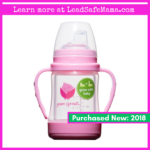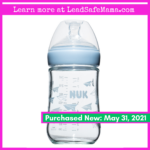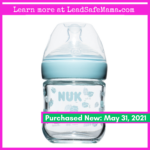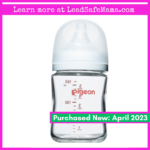Short Glass Baby Bottles
Introduction (for those new to this website):
Tamara Rubin is a multiple-federal-award-winning independent advocate for consumer goods safety and a documentary filmmaker. She is also a mother of Lead-poisoned children (her sons were acutely Lead-poisoned in 2005). Since 2009, Tamara has been using XRF testing (a scientific method used by the U.S. Consumer Product Safety Commission) to test consumer goods for toxicants (specifically heavy metals — including Lead, Cadmium, Mercury, Antimony, and Arsenic). All test results reported on this website are science-based, accurate, and replicable. Items are tested multiple times to confirm the test results for each component tested. Tamara’s work was featured in Consumer Reports Magazine in February of 2023 (March 2023 print edition).
If you are here because of our PSA campaign on the NYC Subways, you are probably new here! Please read the article below, but here are some links with additional info, too!
- Lead Safe Mama, LLC’s “About” Page
- Lead Safe Mama, LLC’s Business Model
- A post explaining WHY we decided to do a PSA campaign (for consumer goods safety and childhood Lead poisoning prevention) in the New York City Subways
- A page for press inquiries (folks wanting to do a news story about the issues raised by this PSA campaign)
- How YOU can participate in and support the work of the Lead Safe Mama community
- Upcoming NYC PSAs we would like to do (along with our funding needs to continue and expand this project)
- The documentary feature film on childhood Lead poisoning, directed and produced by Tamara Rubin
Click any of the images below to read about the Lead levels and concerns for the particular glass baby bottle pictured, or continue reading below for a broader discussion on the issue of Lead-painted glass baby bottles manufactured and sold in the United States (and around the world) today.
Lead-painted baby bottles purchased in 2018
Lead-painted baby bottles purchased in 2021
Lead-painted baby bottles purchased in 2023
Updated: June 4, 2023 — Sunday
The concern for Lead (& other toxicants) in the paint used on glass baby bottles
Authorities in the United States and Europe have known for decades (and possibly longer) that it is unsafe to decorate the exterior of glassware with paints that contain high levels of metallic neurotoxicants (e.g. Lead, Cadmium, Mercury, Arsenic, and Antimony).
In 2008, the United States Government passed the Consumer Product Safety Improvement Act (CPSIA). While this legislation does not regulate the presence of Lead (and other toxicants) in ALL glassware or dishes, it does specifically regulate the presence of Lead (and other toxicants) in newly manufactured “items intended for use by children.” This legislation stipulates that the intent behind the design and manufacture of the item is key (the intended user must be children for the law to be relevant). There is therefore no question that painted/decorated glass baby bottles need to be compliant with the CPSIA, as these products are specifically and intentionally designed for use by babies and toddlers.
All of the Lead-painted glass baby bottles featured in Lead Safe Mama, LLC’s New York City Subway PSA campaign (June 2023) were purchased long after the CPSIA became enforceable (long after 2008) and should be recalled by the CPSC. In fact, the dates when the bottles featured in the campaign were newly purchased range from 2018 to 2023 (starting more than 10 years after the implementation of the CPSIA — a point at which all manufacturers should have known better), with most of the featured bottles in the campaign purchased between 2021 and 2023. Please look at the green band on any of the key images for the date the bottle was purchased new.
Section #1) “How much Lead is ‘too much’ Lead?”
The CPSIA regulates that Lead content in paint or coatings (including on the outside of decorative glassware) on items intended for use by children, must not exceed 90 ppm.
In the examples of glass baby bottles shown at the top of this page (which is not an exhaustive list of Lead painted baby feeding products, merely a sampling of the products Lead Safe Mama, LLC has discovered/tested in recent years), the measured Lead levels in the painted markings and decoration most often exceed 10,000 ppm (and frequently even exceed 20,000 ppm Lead). This is an unconscionable amount of Lead in paint to find on a baby bottle manufactured and solid in this century.
Many of the baby bottles featured in this PSA campaign also had paint that tested positive for one or more metallic toxicants other than Lead — including, but not limited to, Mercury, Cadmium, Antimony, Cobalt, and Titanium (Titanium Dioxide was recently identified by the EU as a carcinogen when ingested — link with more information here).
What these numbers indicate is that these glass baby bottles highlighted in this PSA campaign should be subject to highly-visible public recalls, as they are unsafe and illegal.
Section #2) “But it’s only on the outside — I don’t understand how this could poison my child!”
Numerous scientific studies — including this study from Plymouth, England in 2017 (link) — have repeatedly confirmed that even though the high-Lead paint on glassware (including baby bottles) is normally “only on the outside” of the product, the toxicant (heavy metal) content of this paint still has a significant opportunity to cause harm (through ingestion pathways/ from normal hand-to-mouth behavior).
For context, it is essential to understand how it has long been known (for millennia!) that Lead is such an incredibly potent neurotoxin, and that it literally only takes a microscopic amount of Lead to poison a human being (“microscopic” = without the aid of a microscope, i.e. “with the naked eye”). It is not possible to see the tiny amount of Lead micro-dust that is enough to poison a human, especially the amount that is enough to poison a baby/toddler.
I have written in detail about the concern for the potential impacts of Lead on the outside of painted glassware — including baby bottles (articles with the full discussion can be found here and here). But in short, given it takes just a microscopic amount of Lead to poison a human, the tiny (invisible) particles that wear off of baby bottles with normal use as intended (rubbing off onto the hand or lips of the user, or into the kitchen environment where dishes/bottles are stored/cleaned) are enough to significantly contribute to the cumulative body burden of Lead (and/or Cadmium, Mercury, and Arsenic) exposure levels for a human being.
It is our aggregate, cumulative exposure to these persistent background levels of toxicants that have been conclusively demonstrated to precipitate future health impairments (read more about symptoms here). It is, therefore, these (individually) seemingly minor sources of exposure that we need to try and avoid. If there are known potential sources of exposure that we can easily avoid, we should try to avoid them — especially since unpainted/undecorated clear glass, toxicant-free baby bottles are inexpensive and easy to find (at Target, Walmart, Dollar Store, etc.). Here is the link to the Lead Safe Mama Baby Bottle Guide, which includes many Lead-free options.
Section #3) “What should I do if I have been using these Lead-painted glass baby bottles — is my child Lead-poisoned for sure?”
- First — stop using any of the specific Lead-painted glass baby bottles pictured in the Lead Safe Mama, LLC New York City Subway PSA Campaign (or any other Lead-painted glass baby feeding products we have tested and found to test positive for high-Lead-content paint).
- Consider either setting them aside (to request a refund) or throwing them out (in the trash, making sure they are broken up so no one can use them again in the future).
- While it is frustrating from an environmental perspective, these Lead-contaminated baby bottles cannot be safely recycled and they really cannot be kept safely as a keepsake since someone may choose to use them when feeding a child in the future (not realizing they are unsafe). You can read more about that conundrum on this link.
- If you are unsure whether your baby-feeding products (baby food storage jars, breast milk storage jars, baby bottles, sippy cups, water bottles, etc.) are painted with Lead paint (or have other Lead concerns), start by looking up your products here on this website. There is a search bar at the top of every page of the site where you can enter the brand name of the product OR you can start your search by looking through the website menu linked at the top of every page of the site (here is a direct link to that website menu).
- The health-related concern with items like these Lead-painted baby bottles is not about whether or not using a Lead-painted bottle will poison a child to a measurable level of Lead exposure with a single use. The concern (again) is for the child’s aggregate exposure to heavy metals (long-term exposure over time to trace levels of toxicants — including Lead and Cadmium — that will build up in their body and can inflict extreme, permanent damage to a child’s developing brain, bones and teeth, digestive, immune and other systems; as well as be a future trigger for fertility issues, reproductive disorders, arthritis, immune system disorders, early onset Alzheimer’s/ memory impairments, increased risk of heart disease, kidney disease, cancer, and more). You can read more about that at this link.
- If your children have been using any of these products, especially if you have been using them on a regular basis, ask your doctor about getting a Blood Lead Level (BLL) test immediately. (Here’s a link with more information about BLL testing.)
- If Lead-painted glass baby bottles like the ones shown are your child’s only potential source of exposure, a standard BLL test may not come back positive for Lead — because the low threshold of detection of many modern tests is too high to detect persistent/chronic low-level exposure from a single source like this. HOWEVER, in conjunction with our recent findings of Lead paint on the Wee Sprout baby food storage jars, Lead Safe Mama readers have now reported at least four children who tested positive (with a positive BLL in the range of 1 to 2.5 micrograms of Lead per deciliter of blood) with no other known sources of exposure for that child. So we have collected some evidence supporting the assertion that it is not impossible for Lead-painted baby feeding products like these to be the likely sole source of Lead exposure for a child.
- Irrespective of the level of accuracy of the testing lab you may use, if your child has not had a BLL test ever or recently, it is also always good to have a baseline BLL test result for your child, yourself (and every member of your family). This is especially true if you live in an urban area with persistent Lead hazards in the environment (like New York City). So even if your particular lab’s or test’s low threshold of detection is high (like a BLL of 3.0 or 2.0), you will at least know you are not above that threshold. (This is a complicated subtopic, and you can read more about it here and here.)
- “Getting a current BLL test” is advice for people of all ages, not just “children under 6 years old,” which is a relatively arbitrary cut-off point the CDC historically set for Lead exposure screening.
- You can look up your glass baby bottles on the Lead Safe Mama website (by entering a few keywords in the search bar or by scrolling through all the articles that come up when you click this link). However, if you do not find your exact baby bottle with correlating test results, you might find similar ones from the same brand, in which case it is safe to extrapolate the test results to your bottle (in the case of a product from the same brand, made of the same materials). If you would like to send a newly purchased baby bottle into us for testing and reporting on (to support this initiative/ because you do not see your bottle brand with test results listed here on LeadSafeMama.com), please check out this link to learn more.
- “Bigger picture” considerations:
- As consumers, we really need to demand that our government make the Lead on food-use products like baby bottles and other glassware illegal — period. We need to demand this in all applications and for all intended users, not just for products made for use by babies and young children. Unfortunately, given the enormity of the powerful, monied interests arrayed in favor of the profitable and convenient continued use of these metallic toxicants in paints and coatings, and the concentration of ownership and control of corporate media (with substantial overlap between the two!), frighteningly few parents have learned about this issue and thus we do not yet have the level of public awareness required to generate the political will to make this happen.
- Our intention for this PSA campaign is that it will help generate a new level of awareness as a first step.
- We also need to hold companies accountable for their previously-manufactured Lead-contaminated baby feeding products — especially products made after the CPSIA was passed in 2008. Specifically, we need to demand that the CPSC and manufacturers issue public recalls for these toxic products so it is at least public record that they are unsafe for use. In addition to filing complaints with the CPSC if you own/have owned one of these toxic products (here is the link to file a complaint), one other simple way to support this effort is for consumers to write directly to the manufacturers of whichever Lead-painted baby bottle brand they unknowingly chose for their children — demanding that refunds and recalls be initiated on these products.
Section #4) “But isn’t Lead paint in older homes the real problem? Isn’t a concern for Lead in consumer goods misplaced, relatively?”
The short(ish) answer is, “Yes — the leading cause of childhood Lead-poisoning is inhalation and/or ingestion of invisible Lead micro-dust from the legacy Lead paint still present in millions of historic homes and other buildings.” (My own children were acutely poisoned by Lead paint in our historic home in Portland, Oregon — you can watch the documentary film I produced and directed on this link). Unfortunately, most people don’t understand how pervasive that problem is and are not in a position to test their homes (or to confront their landlords about testing their homes). Concerns over eviction and homelessness (in response to landlords finding Lead paint in a home) often trump a family’s concern over Lead paint in the home — because most young families simply do not understand the significant impacts that Lead can have on our lives (and the long-term costs of those impacts). Learning about Lead in consumer goods is “easier” (less confronting) than learning about Lead in homes, and so we feel this is a good introductory point of entry to learning about the issue.
I often say that the opportunity to learn about toxicity in consumer goods is a “gateway drug” that gets people involved with the issue (my husband hates it when I use that term, but I think it really is a good descriptor — as the issue of Lead in consumer goods is an easy introduction to the much larger issue of Lead’s legacy in our built environment and sets people on a path of awareness and education from which they cannot easily “turn back,” i.e. just forget about and ignore)!
Once parents learn there are neurotoxic contaminants in household items that they own and use every day in their homes, they typically eventually come around to considering that this may, in fact, be a problem impacting their family (and specifically their children).
In response to this new level of awareness, they begin looking at their home, their children’s schools, and other buildings they spend time in, as possible potential sources of Lead-exposure to their children. The normal precipitated response is that they consider getting their children tested for Lead, which is the best possible outcome (increasing the odds that the specific child will potentially be protected from Lead exposure due to early detection and also increasing the available statistical data for scientific studies of the problem — data which will help inspire legislative change that protects future generations of children).
Section #5) What are the Goals of This PSA Campaign?
“Why do a PSA Campaign in the NYC subways?”
I have been reporting about the concern for Lead paint and Leaded glazes used on food-use consumer goods ever since I first became trained and certified in using XRF instrumentation to accurately detect and quantify metallic toxicants (heavy metals) in consumer goods back in 2009.
My Lead-poisoning prevention advocacy work has included crafting legislation to protect children from Lead exposure, and attempts at getting that passed (starting in 2010). Since 2016 — through the work of Lead Safe Mama, LLC (officially incorporated in January of 2018) — we have aggressively been pursuing product recalls, using the mechanisms available with the CPSC and other ways of encouraging corporations to be held accountable for making toxic products. Through all of these efforts (over the past 13+ years) we have learned (relatively definitively) that the legislative process in the United States is broken — and early on we decided that swifter and more impactful progress would be made in this issue through greatly-increased public awareness.
This New York City Subway PSA campaign is a new strategy for generating public awareness. Goals include:
- Encouraging citizens to get their blood tested for Lead (regardless of age, gender, socio-economic status, or other demographic factors).
- Increasing media coverage on the issue of Lead (and other toxicants) in consumer goods, and the need for childhood Lead poisoning prevention.
- Inspiring legislative change (the creation of new legislation or enforcement of existing legislation) for consumer protection, as well as enforcement of that legislation — legislation that is uninfluenced by industry, and instead founded in concerns for human health.
- Influencing the Consumer Product Safety Commission in the direction of issuing highly publicized recall notices for all Lead-contaminated/ Lead-painted/ Lead-containing children’s feeding products.
To read more about the goals of this PSA campaign in greater detail, click here.
Section #6) In Conclusion… & Thank you, for Taking the Time
Lead paint is not just found on and around our homes. Lead poisoning is not a problem that was “solved” with the 1978 ban on Lead paint, nor is it a problem that will be solved with the current infrastructure plan. To actually solve this problem, we need to start with greater public awareness. Public awareness will, in turn, generate the political will necessary to create a world in which no children are poisoned by Lead, ever.
Thank you, for taking the time to read this article; please consider copying the link and sharing it on your social media channels (especially in any social media parenting groups you are part of)!
If you are a media reporter (tv, radio, internet, podcasts, etc.) and are interested in writing a story about this issue — please be in touch (link)! The Lead Safe Mama online community consists of more than 100,000 families who are members of our social media community and have been regular readers of this website (LeadSafeMama.com/TamaraRubin.com) in the past 12 months. These people make up a small part of the more than 2.2 million unique visitors to this website around the globe during this same year-long period — many of whom are parents of Lead-poisoned children. We would be happy to put you in touch with several of these families who are willing to share their personal stories in the service of helping raise awareness of this generally superficially and inaccurately covered issue (when it is covered at all). With your help we may finally solve this problem — as we are now well into the fourth century of what has been called “the perpetual secret epidemic” of Lead-poisoning on this continent (see 1786 Benjamin Franklin letter here).
For more about the context surrounding this issue (including the politics behind it) please watch the preview screener of the documentary feature film I directed and produced about childhood Lead poisoning, linked here.
Tamara Rubin
Mother of acutely Lead poisoned children
Owner — Lead Safe Mama, LLC
Environmental Activist
Children’s Health Advocate
Documentary Filmmaker
The pieces related to this campaign include:
- Lead-painted short baby bottles
- Lead-painted tall baby bottles
- Dishes with high-Lead glaze
- Lead-painted cartoon character (collectible) glassware
- Press inquiries page
- Test results for all items pictured in the campaign
- Article with in-depth discussion as to why we have decided to undertake this as a PSA Campaign with printed panels in the NYC Subway

















